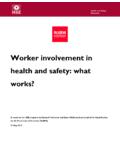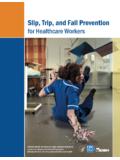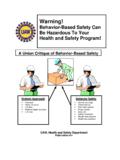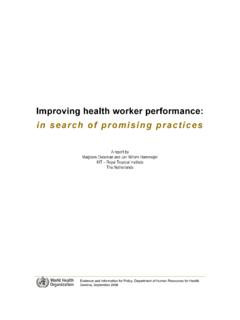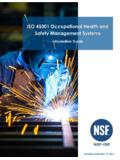Transcription of RR896 - Leadership and worker involvement on …
1 health and safety Executive Leadership and worker involvement on the olympic Park Prepared by the Institute for Employment Studies for the health and safety Executive 2011 RR896 Research Report health and safety Executive Leadership and worker involvement on the olympic Park Daniel Lucy (BSc, MSc) Penny Tamkin (BSc, PhD) Claire Tyers (BSc, MSc) Ben Hicks (BSc) Institute for Employment Studies Sovereign House Church Street Brighton East Sussex BN1 1UJ This research considers Leadership and worker involvement practice across selected projects on the London 2012 olympic Park. The aim was to understand the degree to which the various approaches impacted positively or negatively on worker involvement in health and safety matters, and identify what could potentially be transferable both to other construction projects and to industry more widely. More specifically, this research project sought to explore in more detail the range of initiatives and approaches used, for example behavioural safety training and daily activity briefings (DABs), assessing their impact on worker involvement , attitudes and behaviours and other desired outcomes.
2 The research explored these issues through a review of documents, analysis of existing data, four in-depth case studies of projects within the olympic Park, interviews with senior leaders from the olympic Delivery Authority (ODA) and CLM (a delivery partner appointed by ODA to manage the construction programme), and an indicative survey of worker (including managers, supervisors and operatives) views. The context for the research is a strong public commitment to safety from the ODA resulting in a remarkably good safety record that was recognised in the form of a five star award for safety from the British safety Council. This report and the work it describes were funded by the health and safety Executive (HSE). Its contents, including any opinions and/or conclusions expressed, are those of the authors alone and do not necessarily reflect HSE policy. HSE Books Crown copyright 2011 First published 2011 You may reuse this information (not including logos) free of charge in any format or medium, under the terms of the Open Government Licence.
3 To view the licence visit , write to the Information Policy Team, The National Archives, Kew, London TW9 4DU, or email Some images and illustrations may not be owned by the Crown so cannot be reproduced without permission of the copyright owner. Enquiries should be sent to This research is part of a suite of research projects and independent evaluations undertaken on health and safety on the London 2012 construction programme comprising: n Leadership and worker involvement . n Site communications and other health and safety Initiatives. n CDM 2007 Regulations: duty holder roles and impact. n safety climate tool and measuring site culture. n health and safety in the supply chain. n Occupational health programme provision on the olympic Park and Athletes Village. n Food safety and sustainability. n Preconditioning for success. All the research reports should be read in conjunction with the paper below, which provides an overview of health and safety on the London 2012 construction programme: n Delivering health and safety on the development of the London 2012 olympic Park and Athletes Village.
4 Full research reports for all projects will be published at a later date. ii CONTENTS KEY MESSAGES VII EXECUTIVE SUMMARY IX Park-wide findings ix Project-level findings ix Benefits xii 1 CONTEXT 1 Building the olympic Park 1 health and safety on the olympic park 1 Role of the HSE on the park 4 Why Leadership matters 4 The importance of worker involvement 5 health and safety issues for the construction sector 9 Research aim and scope 10 A brief note on terminology 12 2 RESULTS 13 Park-wide findings 13 Project-level findings 17 Benefits of the approach taken 25 How transferable is the approach taken to Leadership and worker involvement in health and safety to other construction projects and other industries?
5 26 APPENDIX 1 ILLUSTRATIVE CASE STUDY 28 Background 28 The challenge 28 Leadership 28 Behavioural-based safety 29 Communication 30 Reward and recognition 30 Feedback 31 Benefits 31 APPENDIX 2 DETAILED METHODOLOGY 32 Data review and selection of case studies 32 Case studies 32 worker survey 34 APPENDIX 3 PROJECT-LEVEL CASE STUDY PARTICIPANTS 35 APPENDIX 4 EXAMPLE CASE STUDY DISCUSSION GUIDES 36 Discussion Guide: Tier 1 health and safety Manager 36 iii APPENDIX 5 worker SURVEY INSTRUMENT 42 Appendix 6 worker SURVEY RESULTS 48 involvement and communication of health and safety issues 52 Experiences on the project 56 health and safety on the project compared with projects outside the olympic Park 57 APPENDIX 7 HS&E SCORECARD 61 iv ACKNOWLEDGEMENTS This research would not have been possible without the support received from staff from both the HSE and the olympic Delivery Authority (ODA).
6 The authors would like to acknowledge the support provided by Paul Cook, HSE s policy lead on Leadership and worker involvement matters and the project lead for this research supported by Susan Robinson and Sarah Bates (from HSE s Workforce and Leadership Policy Team). Paul chaired the HSE research project team, and the authors would like to thank it s members for their contributions, specifically Anthony Burke (Social Researcher), Jon Bohm and Ed Milnes (Human Factors), Gordon Crick (Construction Division), Andrew Cottam (Managing for health and safety lead), Maria Ottati (Economist) and Kerry Hogan (Statistician). In addition, Louise Brearey, HSE s lead on health and safety arrangements and legacy from the London 2012 Games. The authors would also like to acknowledge the support of staff at the ODA. These include: Lawrence Waterman, Karen Elson, Clare Ramsden, Heather Pilkington and Ros Seal.
7 V vi KEY MESSAGES Available data indicates positive health and safety outcomes for the olympic Park. By June 2011 the olympic Delivery Authority (ODA) recorded around 62 million man hours worked with an accident frequency rate (AFR) of (calculated per 100,000 hours worked). In addition, 22 periods of one million man hours have been worked without a RIDDOR-reportable injury accident1. ODA had a significant impact on health and safety .
8 One of the clearest and strongest elements in creating a strong safety culture was the role played by the ODA in articulating a clear vision, priorities and a strategy for health and safety . The ODA produced a clear statement of its expectations which incorporated a set of standards concerning health and safety , including requirements for effective (two-way) communication, behavioural safety , and reward and recognition. Project leaders (from both the ODA and their delivery partner, CLM) engaged with the supply chain and developed a collaborative, mutually responsible, challenging and learning culture where each Tier 1 contractor assumed accountability not only for their own area but across the site. Alongside this engagement, there was also a willingness amongst the project leaders to stop work if standards were not met. A wealth of data was collected, reviewed and analysed by CLM enabling the identification of trends, the spotting of problems, and the discussion of how health and safety could be improved.
9 The focus on analysing the data and subsequent action served to emphasise the senior-level commitment to health and safety . Effective communication both up and down the chain of command was achieved through the use of a variety of methods (induction, daily pre-task briefings, meetings, posters, safety alerts, anonymous near-miss reporting) and constant reinforcement. Multiple opportunities existed for two-way dialogue and this was supported by behavioural safety initiatives such as a course for supervisors designed to improve their communication skills and ability to engage the workforce. Providing feedback to workers on issues they had raised, and the actions taken as a result, was felt to be key in maintaining their engagement. The commitment of senior managers to health and safety on site was emphasised by their delivery of a number of briefings, their attendance at health and safety meetings, and their regular presence on site.
10 Behavioural safety initiatives sought to engage workers with health and safety , and to make safety personal to them. In addition, specific initiatives were aimed to encourage workers to observe and provide feedback on other work areas (with the permission of those working in the area). Good safety practice was recognised through incentives and awards (breakfast vouchers, and branded badges and fleeces). 1 RIDDOR -Reporting of Injuries, Diseases and Dangerous Occurrences Regulations vii viii EXECUTIVE SUMMARY The olympic Park has proved to be a unique experience, both in terms of the construction of a complex set of venues and associated infrastructure, and in terms of the way in which it has been done with considerable regard to a set of values and targets.










